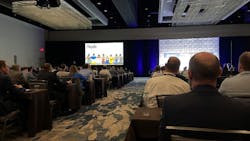Suppliers of both machine vision and robotic products experienced a record year in 2022. That was a major takeaway from the A3 Business Forum 2023, held in mid-January 2023 in Orlando, Florida, USA.
Primarily a networking event for A3’s (Ann Arbor, MI, USA; www.automate.org) members, the meeting also includes sessions covering business and economic trends for suppliers and end users of products in machine vision, robotics, motion control, and AI. At this year’s meeting, some speakers discussed their use cases for machine vision and automation in industries as varied as retail and agriculture.
A record number of people, 680, attended the event, including 200 first-time attendees. They heard from speakers who are bullish about the prospects for industrial automation.
For example, Gaurav Mittal, Managing Director of Thomas H. Lee Partners, a private equity investment firm, said a convergence of macroeconomic trends will spur the adoption of automation including the labor shortage, inflation, de-globalization, supply chain deficiencies, and environmentalism. “Adopting automation addresses all of these issues,” he said.
Historic year in 2022
As is typically the case at the meeting, Alex Shikany, Vice President of Membership and Business Intelligence at A3, presented an overview of business trends in machine vision and robotics.
For machine vision in North America, revenues reached $3.116 billion in 2022, up 3% from $3.019 billion in 2021 and $2.651 billion in 2020.
“This is the second time in our history that we have been over $3 billion in the machine vision market, driven primarily by growth in cameras. Camera companies had a good year in 2022. The other component markets—lighting, optics, imaging boards—didn’t quite grow at the level of cameras,” Shikany said, noting that software revenues also were up slightly.
Compared with 2021, revenue was up 19.4% for cameras and 1.9% for software. Revenues decreased in 2022 for lighting (-5.2%), optics (-4.4%), and imaging boards (-4.4%), compared with 2021.
Suppliers of turnkey machine vision systems, which are designed to solve a specific problem, also experienced a slight (-1.1%) revenue decline in 2022, compared with 2021, while smart-camera revenue was up 15.2%.
Meanwhile, in robotics, 2022 “was a record year,” Shikany said. A total of 44,196 units were ordered in 2022, compared with 39,708 in 2021. However, both revenue and units ordered dropped in the fourth quarter of 2022, he added.
“What drove a record year was the return of the automotive orders,” he added. In 2022, suppliers in non-automotive sectors sold 20,389 robotic units, compared with 23,807 units in the automotive sector.
Outlook for 2023
Shikany also discussed prospects for 2023 for the machine vision/imaging industry, based on the results of a survey of end users conducted jointly by A3 and Vision Systems Design. Despite global concerns about a general economic slowdown, many survey respondents expect to increase their purchases of vision/imaging products over the next 12 months, Shikany said.
When asked recently how they expect their purchases of vision/imaging products to change over the next 12 months, 62% of 404 respondents expect to increase their orders, 34% expect their orders to be flat, and 4% expect to decrease their orders.
Respondents also were asked, “Is economic uncertainty impacting what vision/imaging products you specify for systems you design?” They were nearly evenly split in their answer, with 51% saying, “yes,” and 49% saying, “no.”
When asked what actions their organizations would take as a result of economic uncertainty, 44% said they’ll closely watch spending, 25% will delay machine vision projects, 22% will expand their list of suppliers, 6% will scale back machine vision projects, and 3% won’t change course.
“You may find this if you sell in machine vision and imaging; be ready for that. Half the respondents said, ‘Well, we are watching our budgets a little bit,’ ” Shikany explained.
In an overall sense, Alan Beaulieu, President of ITR Economics (Manchester, NH, USA; www.itreconomics.com), told A3 meeting attendees that he does not expect a recession in 2023 in the “industrial world” (which is separate from consumer spending), although he does expect one in 2024. However, the “recession will be mild,” he said, adding, “If you prepare for it, you will be fine.”
About the Author
Linda Wilson
Editor in Chief
Linda Wilson joined the team at Vision Systems Design in 2022. She has more than 25 years of experience in B2B publishing and has written for numerous publications, including Modern Healthcare, InformationWeek, Computerworld, Health Data Management, and many others. Before joining VSD, she was the senior editor at Medical Laboratory Observer, a sister publication to VSD.

